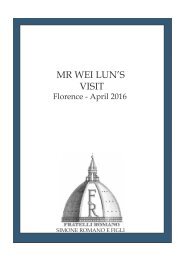A selection of master drawings 2016
- No tags were found...
Create successful ePaper yourself
Turn your PDF publications into a flip-book with our unique Google optimized e-Paper software.
2<br />
Lombard Artist -16 th century<br />
Eucharistic Adoration with St. Francis, St. Clare and worshippers<br />
Pen and brown ink, with brown wash, heightened with white and traces <strong>of</strong> squaring in chalk on laid blue paper<br />
340 x 233 mm (13 ⅜ x 9 ⅛ in.)<br />
Inscriptions: on the old mount, bottom right corner in ink Collez. Durazzo.<br />
According to the inscription on the old mount, the<br />
drawing, which we are presenting to the public for the<br />
first time here, was part <strong>of</strong> the collection <strong>of</strong> one <strong>of</strong> the<br />
most renowned noble families <strong>of</strong> Genoa, the Durazzo<br />
family.<br />
A precise attribution has yet to be found. The sheet<br />
has great executional quality and iconographic interest<br />
and due to its technical and stylistic features, it can<br />
be recognised as the work <strong>of</strong> a northern Italian artist,<br />
probably from Lombardy, active during the last thirty<br />
years <strong>of</strong> the 16 th century. The creator <strong>of</strong> our drawing<br />
entrusts the definition <strong>of</strong> the volumes to the action <strong>of</strong><br />
the light; they are built up in white lead which is applied<br />
in delicate stripes, bringing out the blue colour <strong>of</strong> the<br />
paper. This is an effect which tends towards painting, and<br />
is typical <strong>of</strong> northern Italian artists, in particular <strong>of</strong> those<br />
from Lombardy, who share a fancy for tinted paper and<br />
strong tonal contrasts.<br />
The drawing was executed in preparation for a devotional<br />
image. The composition, simple in its structure, regular in<br />
size, and essential in exposure, is scrupulously aligned with<br />
the iconographic decrees imposed by the post-tridentine<br />
catholic reforms. It was in the years that followed the<br />
closure <strong>of</strong> the Council <strong>of</strong> Trent (1563) that St. Francis<br />
and St. Clare, founders respectively <strong>of</strong> the Franciscan<br />
order and the Poor Clare nuns, and protagonists <strong>of</strong> our<br />
drawing, acquired even more fortune in the field <strong>of</strong><br />
catholic devotional painting 1 .<br />
The sheet portrays a choral scene at the centre with the<br />
two saints who raise to the heavens, as a sign <strong>of</strong> devotion,<br />
a Gothicised shaped precious monstrance. It has the<br />
architecture <strong>of</strong> a shrine with an ornate circular base with<br />
pinnacles and gablets, and the top is decorated with three<br />
spheres and a cross and inside with a Christ crucifix.<br />
The northern features <strong>of</strong> this elegant piece <strong>of</strong> goldwork,<br />
perhaps inspired by an object from reality, would seem to<br />
serve as further guidance in identifying the area where the<br />
piece originates from.<br />
Arranged in a semicircle around the two saints, with<br />
the women on one side, the men on the other, are the<br />
worshippers. They are kneeling before the sacrament <strong>of</strong><br />
the Eucharist, symbolised by the precious monstrance<br />
whose sacredness is emphasised by the presence <strong>of</strong> the<br />
piece <strong>of</strong> cloth used by the two saints to raise the object<br />
to the heavens, thus avoiding the direct contact <strong>of</strong> their<br />
hands with the symbol Jesus’s sacrifice. The theatrical<br />
effect <strong>of</strong> the ceremony, performed in the foreground, is<br />
accentuated by the presence <strong>of</strong> two little angels standing<br />
on the two columns in the background, which support a<br />
pair <strong>of</strong> curtains, thus introducing the worshippers to the<br />
mystery <strong>of</strong> the Eucharist. It is the view <strong>of</strong> the monstrance<br />
which arouses in the worshippers a certain feeling <strong>of</strong><br />
wonder revealed by the expansive arm gestures which<br />
we see in the two devotees kneeling in the foreground.<br />
The privileged positions <strong>of</strong> the man and woman, and the<br />
clothing corresponding to sixteenth century fashions,<br />
could suggest that they are the patrons.<br />
The drawing presents the finished character <strong>of</strong> a scale<br />
version and the squaring, which has partially disappeared<br />
but is still quite visible, suggests that the piece was<br />
translated into a painting. It remains to be discovered<br />
whether or not the drawing was used as the model for an<br />
altarpiece or for a mobile painting. The vertical format,<br />
and the total lack <strong>of</strong> spatial indications could, perhaps,<br />
lead one to think that it was intended for the creation <strong>of</strong><br />
a processional banner, for which it was necessary to create<br />
a simple image, without excessive frills, which guaranteed<br />
that the public could read it clearly, even from a distance.<br />
1 On this subject see L’immagine di San Francesco nella Controriforma,<br />
exhibition catalogue by S. Prosperi Valenti Rodinò, C. Strinati,<br />
Rome, Calcografia, 9 December 1982 - 13 February 1983.





